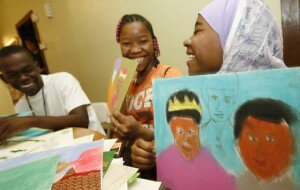
Refugees from Kenya living on the West Side, from left, Yonis Osman, 17; Safiya Osman, 15; and Habiba Noor, 14, each selected an East African folktale to illustrate for a recently published book. Before setting pencil to paper, the youths analyzed and enacted their stories. Derek Gee / Buffalo News
By Deidre Williams (The Buffalo News)Â — There is an African folktale about a race between a hare and a chameleon.
The speedy hare is winning, while the much slower chameleon tries without success to overtake him.
Then the chameleon has an idea and concocts a scheme to defeat the bunny: He cheats.
To find out how and if he won the race, get a copy of “Under the Story Tree: Folktales from East Africa.â€
The book was illustrated by four young refugees from Africa who now — or used to — live on Buffalo’s West Side. Habiba Noor, Safiya Osman and Yonis Osman (no relation) were born in Kenya of Somali Bantu ethnicity. Fifteen-year-old Gbokolo Sambola, a native of Liberia, also participated but has since moved to Tennessee.
In Africa, folktales are not just for children, said Houghton College education professor Daniel Woolsey, who compiled and edited the book. Very often at the end of the day, the villagers get together and trade stories.
It’s their version of television “without the commercials,†he said.
“I liked it,†said 15-year-old Safiya, referring to working on the book. Safiya has lived in Buffalo for the past five years with her aunt and cousins. She will be a ninth-grader in the fall at Leonardo Da Vinci High School.
“I like drawing, and it was fun,†she said.
From a pool of 55 African folktales to choose from, the children selected five stories to illustrate for the book. Under the direction of Cornelia Dohse-Peck, they met regularly for about three months to work on the project. They read the stories aloud, played them out, talked about them and analyzed them.
Then they drew and painted pictures, said Dohse-Peck, a Germanborn visual artist.
“I wanted the drawings to come from within. I wanted them to create artwork that meant something to them, not just Western artwork,†said Dohse-Peck. “Western isn’t bad. I just thought, for them, I wanted to capture their culture.â€
Woolsey, who considers Africa his homeland in many ways, spent the first 11 years of his life in Sierra Leone, where his parents were missionaries.
“In that way, I gained a love for African folktales,†he said.
In the fall of 2007, he took a sabbatical and went to Tanzania to collect the stories, returning with 55 of them.
Last year, he contacted Hope Refugee Services for help in identifying kids to work on the artwork featured in the book.
“Oral tradition is very important. It’s about handing down culture,†said Bonnie MacBeth, Hope Refugee executive director, adding that the Somali Bantu language was not even written until recently.
One of Habiba’s aunts living here already translated the one Somali Bantu story in the book. The other four folk tales are Tanzanian — never before published— in tribal languages and translated into Swahili, then into English.
Quite the storyteller herself, 14-year-old Habiba wrote a story two years ago about two fictional cousins. One was prettier, and the other was meaner.
The moral of the story: “Family is family no matter if you’re pretty†or not, said Habiba, who moved to Buffalo four years ago from a refugee camp in Kenya with her mother and two brothers.
Like Habiba, Yonis Osman came to Buffalo from a Kenyan refugee camp. The 17-year-old Riverside High School senior has lived in Buffalo for the past five years with his family.
Working on the illustrations helped improve his reading skills.
“Reading the stories aloud was good for me because I was having trouble before in school,†he said.
Once the students were finished with the artwork, it was photographed by some of Woolsey’s colleagues from Houghton. Another colleague designed the book using the photographed artwork and the text Woolsey gathered in Tanzania.
Woolsey said he hopes this book is the first of many.
“My goal is that this is just volume one. I hope that publishing these stories and circulating them around . . . will inspire other refugees to [share their folktales],†he said. “I have 50 stories that are waiting.â€
Each book costs $22.95, and copies can be purchased through the Web site www.blurb.com/bookstore/detail/714601 .
By Deidre Williams
Buffalo News






